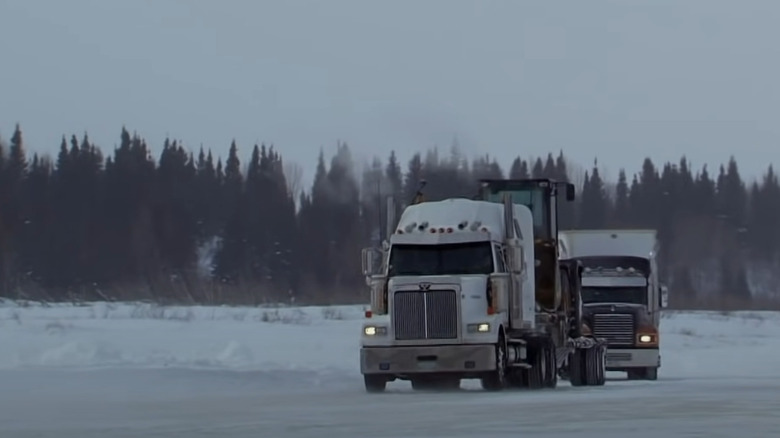The Science Behind Some Of The Most Dangerous Conditions On Ice Road Truckers
If you've ever managed to safely navigate your way home from work on particularly icy roads and think you have what it takes to be an ice road trucker, think again. An ice road is more than just a road covered with ice. According to a Logity Dispatch blog, ice roads are usually made up of actual frozen bodies of water, like lakes and rivers. Ice roads are actually frequently maintained, but that doesn't change the fact that driving a heavy truck over a frozen body of water is incredibly dangerous. Drivers typically have to keep moving because the roads can hold more weight if the truck is moving than it can if the truck is stationary, and yet speeding on the ice road can earn you a lifetime ban.
According to the Alaska Air website, ice roads typically connect remote areas of places like Northern Canada and Alaska where, without the ice roads, they would only be accessible by small planes. Delivering goods by air is a lot more expensive than by truck, and some of the goods that need to be transported are too large for small planes, making trucks the only option.
Frozen rivers can be particularly dangerous for truckers, and to explain why, we have to get into a little bit of science using "Ice Road Truckers" as an example. Don't worry, though, we're not going to get too technical here.
The river currents make it more dangerous
In the "Ice Road Truckers" Season 8 episode "World's End," Lisa Kelly had to traverse what she originally thought was a long lake, but then realized was actually a frozen river. "Oh, it is a river," Kelly exclaimed (via YouTube). "That makes it kind of a little bit more sketchy." The narrator then explained that the current under the ice can make traveling across a frozen river dangerous because, as the current picks up, the ice has trouble staying together, building up cracks in the ice.
In a 2019 blog for North Country Public Radio, James Morgan tried his hand at crossing an ice road made on the Ottawa River connecting Ontario to Quebec. He also described the pressure building up under the ice from the river current as dangerous, saying that the ice road felt like "a series of humps" in some places.
In the episode, Kelly's truck falls through the ice, leaving her with no choice but to use the loader she was hauling to push the truck out of the hole she had created in the ice. This was also a pretty risky venture, but it was really her only way out. Thankfully, the loader was able to free her from the ice and she could continue on her trek across the ice road.

